
Sodium hypochlorite is an alkaline inorganic chemical compound with the formula NaOCl. It is commonly known in a dilute aqueous solution as bleach or chlorine bleach. It is the sodium salt of hypochlorous acid, consisting of sodium cations and hypochlorite anions.

Milano Centrale is the main railway station of the city of Milan, Italy, and is the second busiest railway station in Italy for passenger flow and the largest railway station in Europe by volume.
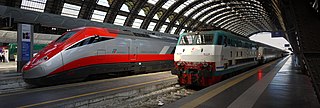
The Italian railway system is one of the most important parts of the infrastructure of Italy, with a total length of 24,567 km (15,265 mi) of which active lines are 16,832 km (10,459 mi). The network has recently grown with the construction of the new high-speed rail network. Italy is a member of the International Union of Railways (UIC). The UIC Country Code for Italy is 83.

The Polytechnic University of Milan is an Italian university located in Milan. It is the largest technical university in the country, with about 40,000 enrolled students. The university offers undergraduate, graduate, and higher education courses in engineering, architecture and design.

Ferrovie dello Stato Italiane S.p.A. is Italy's national state-owned railway holding company that manages transport, infrastructure, real estate services and other services in Italy and other European countries.

Lyon-Perrache or simply Perrache is a large railway station located in the Perrache quarter, in the 2nd arrondissement of Lyon, France. Historically the primary railway station in Lyon, today it is the city's second-busiest station, after the newer Lyon-Part-Dieu station.

The Italian railway system is one of the most important parts of the infrastructure of Italy, with a total length of 24,227 km (15,054 mi) as of 2011.
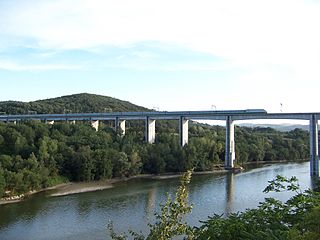
High-speed rail in Italy consists of two lines connecting most of the country's major cities. The first line connects Turin to Salerno via Milan, Bologna, Florence, Rome and Naples, the second runs from Turin to Venice via Milan and Verona, and is under construction in parts. Trains are operated with a top speed of 300 km/h (190 mph).

Bleach is the generic name for any chemical product that is used industrially or domestically to remove color from fabric or fiber or to disinfect after cleaning. It often refers specifically to a dilute solution of sodium hypochlorite, also called "liquid bleach".

Angelini is a large-sized private international group. Founded in Italy in the early twentieth century, the Angelini group has offices in 21 countries. Owned by Angelini family and currently led by Sergio Marullo di Condojanni and Thea Paola Angelini, the industrial group employs approximately 5800 people.
LeNORD S.r.l. was a subsidiary of the FNM Group responsible for operating passenger train services in northern Italy.
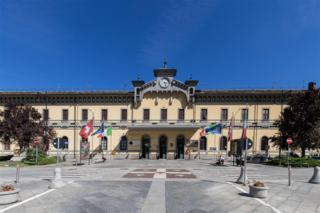
Domodossola railway station serves the city and comune of Domodossola, in the Piedmont region of northwestern Italy. Opened in 1888, it forms a major break of gauge junction between standard gauge lines to Milan, Brig and Novara, and a metre gauge line to Locarno.
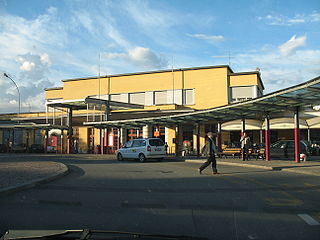
Biella San Paolo railway station is the main station serving the town and comune of Biella, in the Piedmont region, northwestern Italy. It is the junction of the Biella–Novara and Santhià–Biella railways.

Taranto railway station is the main station serving the city and comune of Taranto, in the region of Apulia, southern Italy. Opened in 1868, it forms a junction between three main lines, from Bari, Brindisi and Reggio di Calabria, respectively. It is also a terminus of a secondary line, the Bari–Martina Franca–Taranto railway.
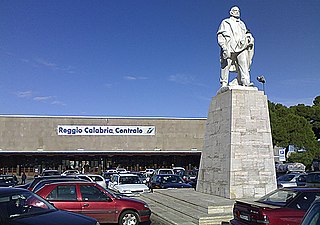
Reggio di Calabria Centrale railway station is the main railway station of the Italian city of Reggio Calabria in Calabria. It is the most important station of its region and is owned by the Ferrovie dello Stato, the national rail company of Italy.
Villa San Giovanni railway station is the main railway station serving the town and comune of Villa San Giovanni, in the region of Calabria, southern Italy. It opened in 1884, and it forms part of the Battipaglia–Reggio di Calabria railway.

Trenord is a railway company which is responsible for the operation of regional passenger trains in Lombardy. The company was established by the two main railway companies in Lombardy, Trenitalia and Ferrovie Nord Milano (FNM), to manage train operations in the region. The equity is equally divided between the two companies.
Trenitalia France is an open-access train operator running international services between France and Italy. It was originally established under the Thello brand in October 2011.
Potassium hypochlorite is a chemical compound with the chemical formula KOCl, also written as KClO. It is the potassium salt of hypochlorous acid. It consists of potassium cations and hypochlorite anions. It is used in variable concentrations, often diluted in water solution. Its aqueous solutions are colorless liquids that have a strong chlorine smell. It is used as a biocide and disinfectant.
Oronzio De Nora was an Italian engineer and entrepreneur, founder of Industrie De Nora and inventor of the Amuchina disinfectant.















